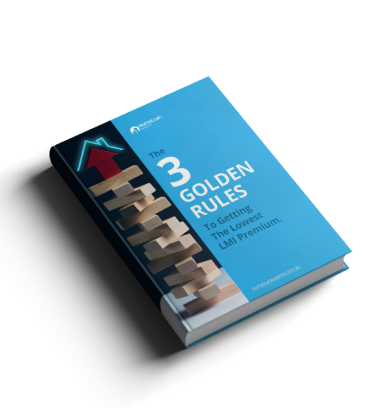Is Lenders Mortgage Insurance a one-off payment?
Lenders Mortgage Insurance (LMI) is usually paid if you’re borrowing more than 80% of the property value.
It can be a one-off fee paid during loan settlement that covers the full term of the loan
However, you also have the option to capitalise the LMI into your loan.
What is LMI capitalisation?
LMI capitalisation is a process where the lender adds the cost of the LMI insurance into your loan amount.
For example, if you borrowed $600,000, the LMI premium would be approximately $16,470.
The LMI premium is deducted from the loan funds when they are advanced and you can only borrow $583,530.
However, if you capitalise LMI, then you can borrow $600,000 + $16,470 = $616,470. This gives you the full amount you were approved for plus the cost of the LMI premium.
The 3 Golden Rules For LMI Premium
Many Australians don’t know what Lenders Mortgage Insurance (LMI) is, even though it can cost you literally thousands of dollars in upfront costs. How can you reduce your LMI premium and save thousands? Download this guide to know.

When do I pay LMI if it is capitalised?
You will pay back the cost of the LMI premium along with your home loan repayments if it is capitalised.
Therefore, depending on your repayment schedule, the capitalised LMI premium amount is paid in instalments.
Are there any benefits to capitalising LMI?
By capitalising the LMI premium, you can get approved for a home loan with a lower deposit as you don’t need to pay LMI upfront. You will pay off the LMI over the life of your loan.
However, the LMI premium will also accrue interest since it is added to the loan balance.
Also, LMI can delay your application process as the borrower needs to satisfy the lending criteria of both the lender and the LMI insurer.
The pros of LMI capitalisation are:
- You may be able to buy your property sooner.
- You may be able to borrow at a higher LVR. Without LMI, you typically have to sit at 80% LVR and make up the 20% deposit.
- It is a favoured option for borrowers who do not have savings or equity to pay LMI upfront.
The cons of LMI capitalisation are:
- The applicable interest rates could be higher at a higher LVR.
- Once LMI is capitalised, you must demonstrate that you can service the loan including the capitalised premium amount
- The home loan repayment amount is higher with LMI capitalised since the interest will be charged on both the loan amount and the LMI premium.
How is repayment calculated after LMI capitalisation?
| Details | Amount ($) |
|---|---|
| Property value | $800,000. |
| Loan amount | $750,000 (total amount after including LMI premium) |
| Base loan amount | $723,960 |
| LMI premium | $26,039* |
| Interest rate | 2.29% |
| Loan term | 30 years |
| Repayment if LMI is paid upfront | $2,782 per month |
| Repayment if LMI is capitalised? | $2,882 per month |
*Please note that the LMI premium is an approximate figure.
If the borrower chooses to capitalise the LMI premium with a home loan at 2.29% interest rate, the LMI is $2,882 per month over the life of the loan i.e. 30 years.
There is a difference of $100 per month between LMI paid upfront and LMI being capitalised.
While repayments are lower if the $26,039 LMI premium is paid upfront, the base loan amount also decreases.
What is the maximum LVR for LMI?
The maximum LVR for LMI is usually 95%.
However, we have lenders on our panel who can go up to 98% inclusive of LMI.
Case study example:
Vernon was a first home buyer, looking to buy in New South Wales. He was looking to buy a property valued at $590,000 and have saved up $34,000. He was also eligible for a $5,000 stamp duty waiver.
His loan to value ratio was 98%.
After an initial conversation with our broker, Vernon was eligible for the 95% + LMI home loan product, i.e. he could borrow up to 98% inclusive of LMI. Vernon’s loan amount would be $563,820 and his lender’s mortgage insurance was approximately $24,200.
To find out which lenders offer higher LVR inclusive of LMI, please call our mortgage brokers at 1300 889 743 or fill in our free assessment form.
How to reduce or waive LMI?
Decrease your LVR
The amount of LMI you pay works on a sliding scale. If the LVR is higher, then the LMI premium will also be higher. Similarly, if the loan value is higher, the LMI premium will also be higher. If you can increase your deposit amount and lower your LVR, then you pay a lower LMI premium.
Use an offset account
If you’re capitalising LMI, it’s good to make use of an offset account as interest is only calculated on the loan balance. Therefore, if you deposit funds into your offset account then the assessable loan balance decreases.
Take advantage of government grants
There are various government grants and schemes available, especially for first home buyers. You can use the First Home Owners Grant towards your deposit. Furthermore, with the First Home Loan Deposit Scheme, you might qualify for a 95% home loan without paying LMI.
Waived LMI for professionals
There are certain professionals like doctors, lawyers, etc who qualify for waived LMI. Therefore, even if they’re borrowing more than 80% LVR, they might be exempt from paying the premium.
Guarantor loan
If possible, getting a guarantor loan is one of the best ways to avoid paying LMI. With a guarantor loan, you can borrow up to 105% of the property value
Compare LMI quotes between lenders
Each lender has different policies regarding LMI so it’s important to choose the right lender. You can use our LMI calculator to find out which lenders offer the lowest LMI premiums.
What option is better?
If you’re still confused about whether to pay LMI upfront or capitalise it to your loan, we’re here to help.
Our mortgage brokers work with over 40 lenders.
They can help you find lenders who offer lower LMI premiums or workshop different deposit and loan amounts so you reduce the amount of LMI paid.
Please call us at 1300 889 743 or fill in our free assessment form.
